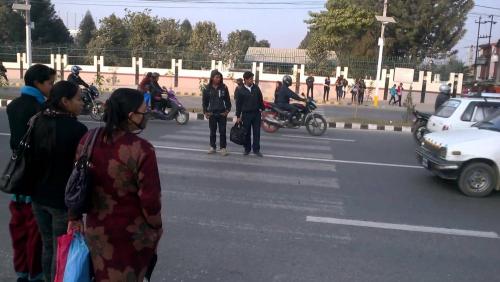
The Metropolitan Traffic Police Division in Kathmandu promptly responded to the worrying data related to the number of deaths due to road accident in the Kathmandu Valley. On average there 150 persons die in the street of the Valley. That’s the reason why the Traffic Division came up with an awareness program mainly targeting pedestrians, teaching them the basic rules of road safety. If not abiding to the rules like for example using the zebra crossings or not using the overhead bridges, the individuals will be fined in the range between Rs 200 and Rs 1000 plus a compulsory re-education program.
This is a good though not a prime, initiative but I can’t understand why the focus is on making the pedestrians the only culprits of road accidents. An article on Republica also mentioned that some new dispositions are aimed at regulating the behavior of the drivers but I am not getting why the threat of fines is only on the pedestrians. What happens when a car does not stop or slow down at the zebra crossing?
Regardless of the drivers’ behavior, pedestrians should always use zebra crossing and overhead bridges, the latter a real pain in the ass for many of us who walk a lot. I do not think overhead bridges are the most effective and pedestrian friendly tools available at all and this is one of the reasons why are not frequently used. At the same time despite our preferences, we have no excuses and we should all use them.
Yet what are the penalties for cars or micro not respecting the rules of zebra crossing? While it is important to educate the pedestrians, I believe it is equally important to educate and penalize the drivers so that more people will start using the zebra crossing as they will feel respected and given due right to cross the streets, something that is not the case right now.
After all it is a cultural (in the broader sense) or simply an habit issue, the same issues that allows parents to have their babies sitting in the front seat, near the driver, something extremely inconsiderate and dangerous.
In Italy for many years people used not to wear security belts while driving. After extremely stiffing penalties were enforced, you either follow the rules or open your wallet to pay hundreds of EURO in fine with the risks to lose your license. It took quite a lot of time to my father, a long distance traveler to get used and it was financially really expensive for him to comply with the new rules as he had to pay several big fines for not using the seat belts. Myself I was not very keen to use the seat belts but now I cannot drive without them. When you embrace a habit, it becomes also a physiological factor you cannot do without.
More awareness and stronger penalties are welcome but we need to have consistency in the long run. The same regulations should apply countrywide and not just as reaction to alarming data.
Drivers like the pedestrians are part of the problem and at the same time part of the solution: any efforts must include and target both groups and not just the latter one.










Add new comment